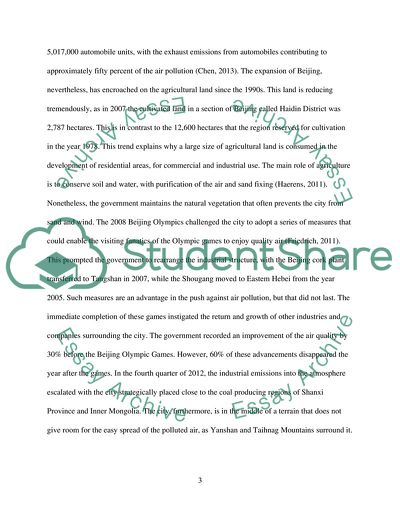Cite this document
(Problem of Air Pollution in Beijing Essay Example | Topics and Well Written Essays - 1500 words, n.d.)
Problem of Air Pollution in Beijing Essay Example | Topics and Well Written Essays - 1500 words. Retrieved from https://studentshare.org/environmental-studies/1875512-identify-a-problem-caused-by-urbanization-in-beijing-and-evaluate-the-effectiveness-of-two-solutions-which-have-been-implemented-to-combat-the-issue-use-data-to-support-your-argument
Problem of Air Pollution in Beijing Essay Example | Topics and Well Written Essays - 1500 words. Retrieved from https://studentshare.org/environmental-studies/1875512-identify-a-problem-caused-by-urbanization-in-beijing-and-evaluate-the-effectiveness-of-two-solutions-which-have-been-implemented-to-combat-the-issue-use-data-to-support-your-argument
(Problem of Air Pollution in Beijing Essay Example | Topics and Well Written Essays - 1500 Words)
Problem of Air Pollution in Beijing Essay Example | Topics and Well Written Essays - 1500 Words. https://studentshare.org/environmental-studies/1875512-identify-a-problem-caused-by-urbanization-in-beijing-and-evaluate-the-effectiveness-of-two-solutions-which-have-been-implemented-to-combat-the-issue-use-data-to-support-your-argument.
Problem of Air Pollution in Beijing Essay Example | Topics and Well Written Essays - 1500 Words. https://studentshare.org/environmental-studies/1875512-identify-a-problem-caused-by-urbanization-in-beijing-and-evaluate-the-effectiveness-of-two-solutions-which-have-been-implemented-to-combat-the-issue-use-data-to-support-your-argument.
“Problem of Air Pollution in Beijing Essay Example | Topics and Well Written Essays - 1500 Words”. https://studentshare.org/environmental-studies/1875512-identify-a-problem-caused-by-urbanization-in-beijing-and-evaluate-the-effectiveness-of-two-solutions-which-have-been-implemented-to-combat-the-issue-use-data-to-support-your-argument.


